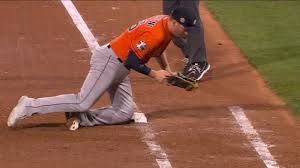We continue our celebration of the Houston Astros winning the 2022 World Series by considering defense in baseball and prevention and detection in a best practices compliance program. According to Stephanie Apstein, writing in SI.com, the situation was in Game 5 in Philadelphia with the following, “Righty Rafael Montero walked two of the first three men he faced, then allowed a single to Jean Segura to plate a run and bring the game within one. Closer Ryan Pressly struck out Brandon Marsh on three pitches to bring up left-handed left fielder Kyle Schwarber, one of the Phillies’ most fearsome hitters.”
With two Philly baserunners on and a 2-2 count in the 8th inning, “Schwarber drilled a rocket, straight at the baseline. Mancini leaned to his right, snared it and, toppling over, stomped his left foot on the base for the out. He looked more like a catcher or a hockey goalie than a first baseman, the textbook approach on a ball like that. If he’d been two steps off the bag, he would not have caught it. “The ball was hit that hard,” Espada said. Instead, inning over. Rally over. Espada smothered him with a hug once he returned to the dugout.” Mancini’s stop save at least one and more probably two runs from coming home to score.
Up until that point, Mancini was hitting a big fat ZERO for the World Series. The only reason he was in the game in such a crucial time was the starting 3rd baseman, Yuli Gurriel, had been injured in the prior inning. Mancini had only played at first base in 30 games in 2022 and had not played the position in a game in nearly 30 days. Yet here he was on the biggest stage, near the end of the game with the Astros clinging to a 3-2 lead, making the biggest play of his career. Mancini said, “I just tackled it, basically.” Apstein went on to note, “He added that given the stakes, this had to have been the best play of his career. “I don’t know how many highlight reel plays I have on defense,” he said, laughing. “Probably not too many.”” (Check out herefor a video of the play.)
Part of Mancini’s story which makes all this much more poignant was that in 2020, when he was 28, Mancini was diagnosed with colon cancer, underwent surgery to have a malignant tumor removed and had chemotherapy. He recovered sufficiently to come back and play in the 2021 season where he was awarded the American League Comeback Player of the Year.
There was another great defensive play from Game 5 that I must mention, which was the catch off the centerfield wall by Chas McCormick in the 9th inning. Alden Gonzales, writing in ESPN, said “The Phillies were down to their final two outs, and their superstar catcher stayed back on a 1-1, outside-corner slider and hit an opposite-field drive that seemed primed for extra bases.” But McCormick, who grew up a Phillies fan made the catch, bounced off the wall and held on to the baseball as he fell backwards. Gonzales called it “one of the most memorable and important in baseball history.” (Check it out here.)
What does all this great defense mean for your compliance program? Just as in baseball, you have to hit, play defense and pitch; every best practices compliance program consists of three parts; prevention, detection and remediation. These three both interact and act separately to fulfill the obligations of a compliance program. One of the best explanations of this tripartite formulation is Paul McNulty’s three maxims of a Foreign Corrupt Practices Act (FCPA) compliance program: 1) What did you do to prevent it?; 2) What did you do to detect it?; and 3) What did you do to remedy it? Just as each prong can stand alone or in concert with the other two, each one of McNulty’s Maxim’s can be asked alone or together with one or more of the other two. For instance, while many compliance professions generally think of internal controls component of a minimum best practices FCPA compliance program and they applied to Maxim 2, detection; they also act to comport with Maxim 1. As a specific focus is needed to ensure there are control procedures in place to ensure compliance with Maxim 1, prevention.
How did that play out in Game 5? According to Apstein, Astro Bench Coach Joe Espada “got Mancini’s attention and motioned for him to move two steps closer to the bag. They needed to prevent a double—Segura is fast enough to score from first and give the Phillies the lead—and they knew Schwarber would try to pull a ball for a home run. “I saw the spin on Pressly,” Espada said, “So I’m like, ‘Dude, just stay on that line.’” In other words, because of the detect component, the prevent component saved at least two runs and the game.
Join me tomorrow as I explore the Astros Manager Dusty Baker and leadership lessons.






